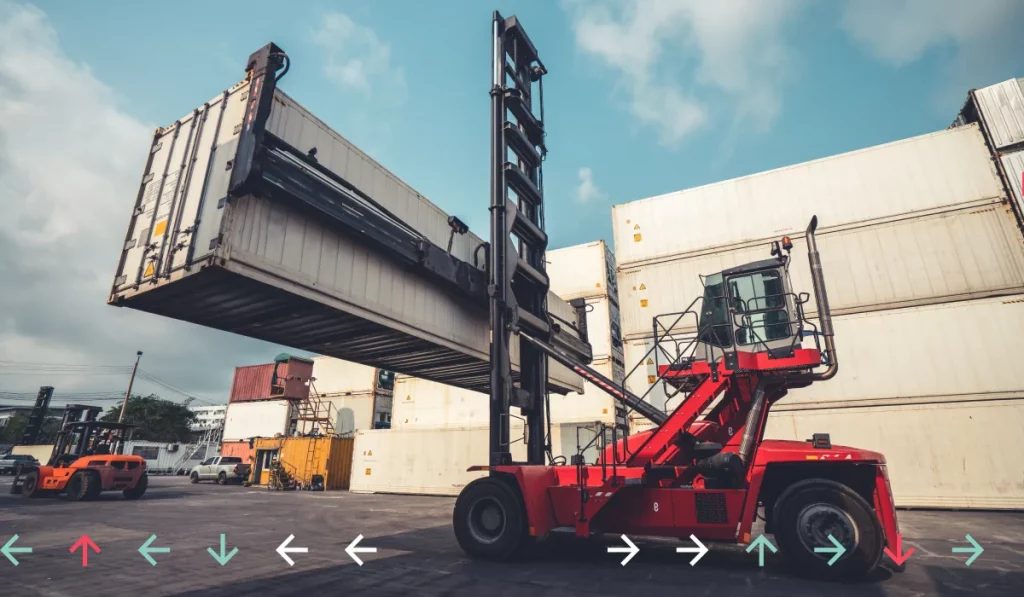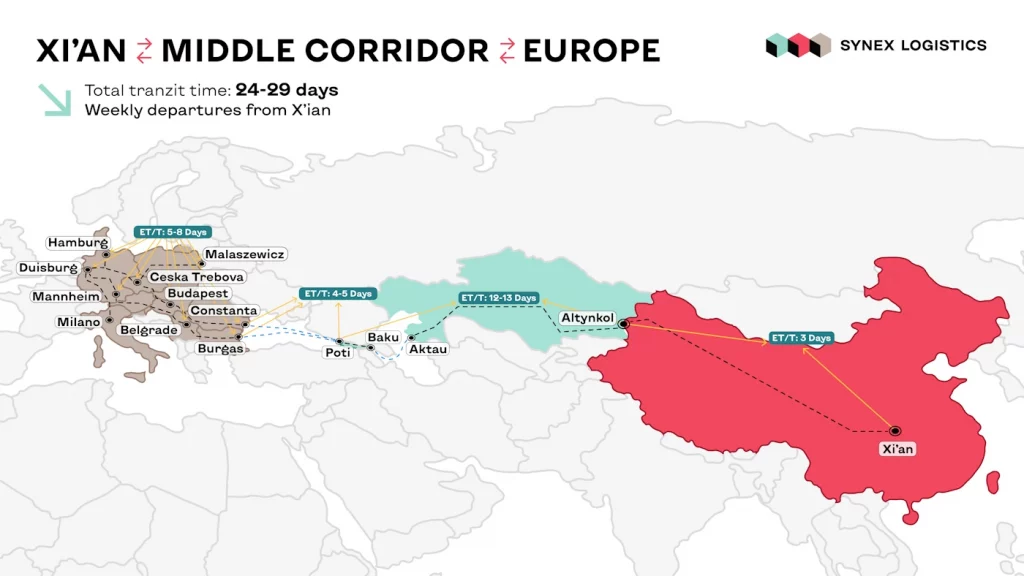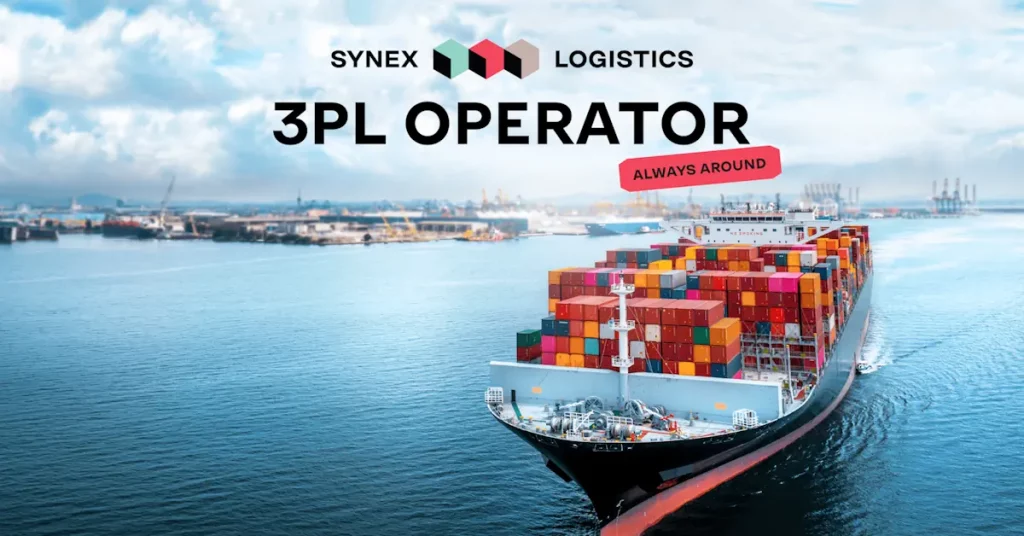Global Logistics Trends in 2025

Modern logistics is a complex ecosystem where technology, AI, and automation play a crucial role. In 2025, the industry will continue evolving under the influence of IoT, robotics, and environmental standards. This article will be useful for logistics companies, manufacturers, and anyone following current industry trends. We will explore the technologies shaping the sector and how they help businesses remain agile and resilient.
Table of Contents:
- Key Focus Areas in Logistics Today
- Leading Freight Transportation Trends in 2025
- What Businesses Should Consider in 2025
- With SYNEX Logistics, Innovation in Logistics is Accessible to Everyone
- Conclusions
Key Focus Areas in Logistics Today
In 2025, logistics continues to evolve through innovations that enhance efficiency and resilience across supply chains. Below are the key focus areas and why they matter:
- Green Logistics – reducing CO₂ emissions and prioritizing environmental responsibility.
- Artificial Intelligence (AI) – optimizing logistics processes for greater efficiency.
- Warehouse Robotics & Automation – accelerating order processing.
- Internet of Things (IoT) – enabling real-time tracking for improved supply chain management.
- Warehouse Management Systems (WMS) & Transportation Management Systems (TMS) – ensuring full control over logistics operations, from procurement to final delivery.
- Digitalization & Blockchain – enhancing transparency, traceability, and trust in freight transportation while mitigating fraud risks.
- Digital Twins – creating virtual models of warehouses, transport hubs, and entire logistics networks to simulate and optimize processes.
- Cybersecurity – protecting digital logistics systems from cyber threats.
- E-commerce Growth – developing fast delivery, automated pick-up points, and last-mile technologies.
Leading Freight Transportation Trends in 2025
In 2025, logistics will undergo significant transformations, driven by technological advancements and evolving business needs. Freight transportation is no exception. Below, we explore the key trends shaping the industry in the near future.
Warehouse Automation Is Gaining Momentum
Warehouse automation is no longer just a trend but a necessity for companies aiming for greater efficiency and speed. By 2025, this process will expand further, as robotics and automation help cut costs, minimize human intervention, and speed up order processing. Autonomous robots handle picking, sorting, and packaging, while Automated Storage and Retrieval Systems (ASRS), Warehouse Management Systems (WMS), and AI-powered conveyor systems optimize storage space, minimize order-picking errors, and free up employees for more complex tasks. As a result, companies gain faster deliveries, stronger customer loyalty, and a more efficient, synchronized workforce.
AI and Transportation Logistics
Modern algorithms help optimize routes, manage freight flows, minimize downtime, and much more:
- Route Optimization – AI analyses road conditions, weather, and warehouse congestion to select the fastest and most cost-effective routes;
- Freight Load Forecasting – AI analyses cargo flows, seasonal fluctuations, and demand to optimize vehicle utilization and minimize empty runs;
- Autonomous Transport – cuts personnel costs, enables 24/7 operation, and reduces human error;
- Intelligent Transport Systems (ITS) manage megacity traffic, reduce congestion, and improve freight transportation by promptly redirecting traffic in unforeseen circumstances;
- Enhanced Customer Service – makes deliveries more predictable by providing customers with precise arrival times, real-time updates on route changes, and instant support through chatbots and voice assistants.

IoT in Logistics and Supply Chains
The Internet of Things (IoT) is making logistics processes more transparent and efficient. Smart sensors provide real-time monitoring of cargo, tracking temperature, humidity, and location—crucial for perishable goods. Smart locks and video surveillance systems protect shipments from theft and damage, while customers can track their orders in real time and receive delivery updates. Additionally, IoT helps manage warehouse inventory and alerts drivers about necessary maintenance, reducing the risk of vehicle breakdowns on the road.
Resilience to Geopolitical Challenges
In 2024, logistics faced global disruptions: Houthi attacks in the Red Sea, drought in the Panama Canal, piracy near the Horn of Africa, tensions in the South China Sea. These challenges disrupted supply chains, while the war in Ukraine further worsened the situation, blocking ports and affecting international trade.
In response, companies have begun diversifying supply chains to reduce dependence on single suppliers and regions. Businesses are seeking alternative routes and localizing production. Flexible logistics solutions and new technologies like AI, blockchain, and digital twins help forecast disruptions, enhance operational transparency, and swiftly adjust routes to avoid high-risk areas. Companies are also shifting to more flexible contracts to respond quickly to market changes.
Green Logistics Attracts More Investments
Companies are actively reducing their environmental impact by adopting eco-friendly technologies and optimizing logistics. Key initiatives include transition to electric and hybrid vehicles and developing the necessary service infrastructure. For example, the startup Aegis Energy secured £100 million to build eco-friendly fueling hubs in the UK, offering biofuel, electricity, and, in the future, hydrogen refueling.
Digital technologies are also helping optimize routes, reducing fuel consumption and lowering carbon footprints. Businesses are actively moving away from single-use plastics, replacing them with recyclable materials to minimize waste. Solar and wind energy are increasingly used to power warehouses and logistics operations.
Investments in green logistics not only contribute to environmental sustainability but also provide companies with competitive advantages, reducing costs and improving brand reputation.
The Growing Role of Multimodal Freight Transportation
Multimodal transportation is gaining popularity due to its efficient combination of different transport modes, which reduces costs and delivery times. For example, freight shipments from Asia to Europe utilize sea, rail, and air transport, each offering distinct advantages: air transportation – ensures speed, rail transportation offers cost-effectiveness.
A key focus is the Trans-Caspian International Transport Route, linking China to Europe. Freight volumes on this route are expected to increase in 2025.

Multimodal transportation allows faster mode transitions, enabling companies to adapt swiftly to changes, disruptions, or force majeure events. Additionally, rail and sea transport are more environmentally sustainable, as they have a lower environmental impact.
Unmanned Small Cargo Transportation
With technological advancements, the rise of e-commerce, and increasing demand for fast delivery, unmanned cargo transportationis becoming a vital tool for businesses. Their key benefits are obvious:
- Cost Reduction – drones can operate 24/7 without the need to rest;
- Faster Delivery – the absence of human factors minimizes delays and optimizes routes;
- Eco-Friendliness – many drones are electric-powered, reducing environmental impact.
By 2025, unmanned cargo transportation is expected to become more widespread. China recently introduced a cargo drone capable of carrying up to one ton, designed for efficient deliveries in remote areas. The US and Europe are already using drones to deliver medicine and groceries. These innovations speed up deliveries, reduce driver-related costs, and lower expenses associated with maintaining traditional vehicle fleets.
What Businesses Should Consider in 2025
Logistics is no longer just about transporting goods from point A to point B. Today, it is a complex, high-tech system that requires flexibility and the ability to respond quickly to changes. Companies that embrace trends, implement new approaches, and respond to global challenges in 2025 will reduce costs and build more resilient supply chains.
The future of logistics lies in digitalization, automation, and environmentally responsible solutions. Investing in new technologies will allow businesses to enhance the speed, transparency, and reliability of logistics operations.
A customer-centric approach, adaptability to new conditions, and commitment to innovation will help businesses not only survive but thrive in this dynamic environment. 2025 is a time of transformation, and those who think ahead will gain a competitive edge by creating smart, adaptive, and resilient logistics systems that can evolve in response to global shifts.
With SYNEX Logistics, Innovation in Logistics is Accessible to Everyone
At SYNEX Logistics, we make modern logistics solutions accessible to businesses of all sizes. We offer professional cargo transportation services to integrate cutting-edge technologies, flexibility, and transparency, helping businesses keep supply chains running smoothly.

Why Choose Us?
- Transparency & Control – you always know where your cargo is and can be assured of its safety.
- Optimized Routes – we develop customized delivery plans, considering cost, speed, and risk factors.
- Extensive Partner Network – as a 3PL operator, we provide access to a full range of transportation, customs, and contract logistics services.
- Comprehensive Solutions – we help businesses leverage the benefits of all transportation modes, selecting the best option for each shipment.
Contact us – we will help you find the best shipping route, provide consultation, and ensure top-tier logistics support.
Conclusions
Logistics in 2025 will be a symbiosis of digital technologies, automation, and cutting-edge solutions. AI, IoT, blockchain, and eco-friendly initiatives are revolutionizing supply chain management, making it more efficient and adaptable to global challenges. Companies that embrace innovation will gain a strong competitive advantage, creating more reliable and transparent supply chains that drive business success in the years to come.




